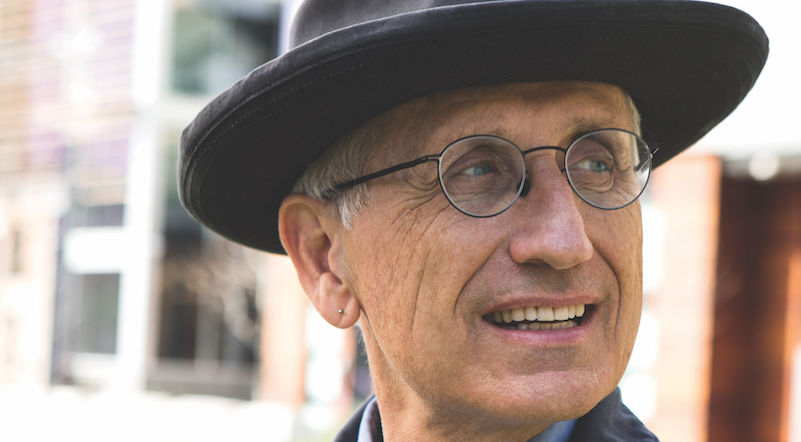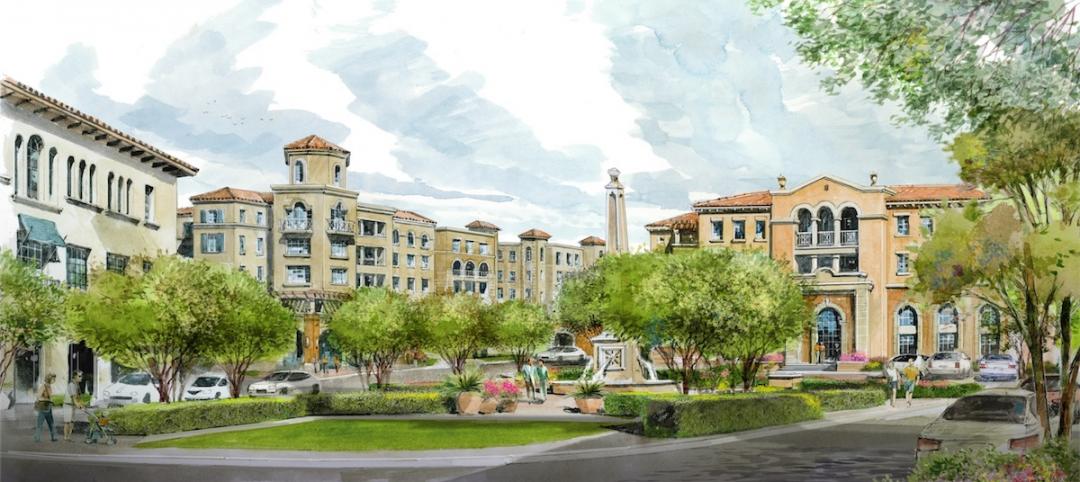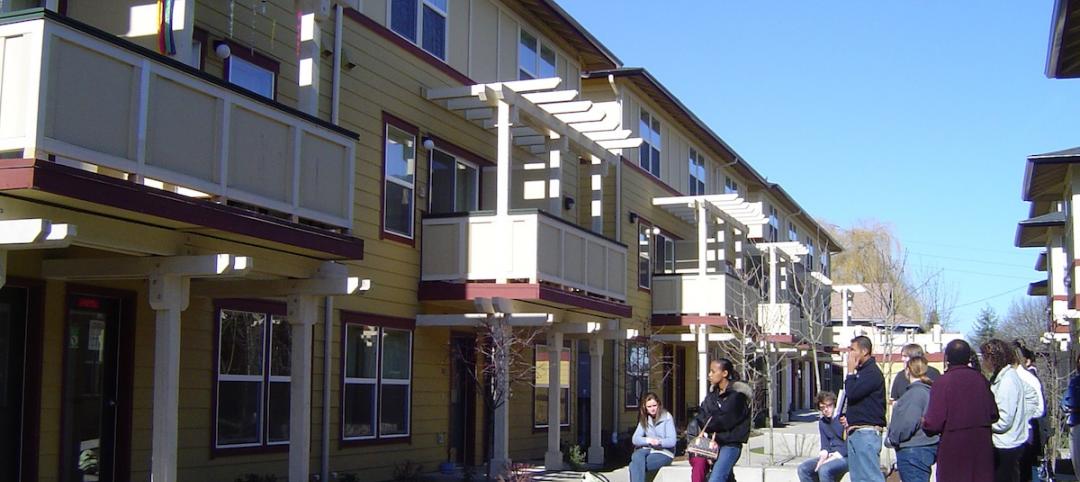David Baker, FAIA, LEED AP, has forged an illustrious career designing stylish and practical market-rate and affordable urban housing, primarily in the San Francisco Bay Area, as well as in Baltimore, Denver, Charleston, S.C., and (coming soon) Seattle.
Witty, urbane, opinionated, and equipped with a rapid-fire patter, the 67-year-old, whose San Francisco–based firm David Baker Architects (DBA) celebrates its 35th anniversary this year, has hewn to a design philosophy that prioritizes the social and financial concerns of the communities in which the firm works.
But Baker, an avid cyclist, knows all too well that getting affordable multifamily housing to the finish line is always an uphill climb, especially when what the community wants is at odds with a city’s planning and growth agendas. Baker cites developers and builders who balk at affordable housing as a market “distortion.” He also singles out an “exhaustive” planning process that, in San Francisco at least, can keep approvals in limbo for as long as five years: As he once told The Architects’ Take, “Building new housing should not be a multi-year journey.”
‘Building new housing should not be a multi-year journey.’
—David Baker
What really irks Baker are the barriers to homebuilding that, year after year, limit supply and drive up prices. Among them: inclusionary fees that developers must pay for the privilege of not having to build affordable housing on site—fees that, in San Francisco, cost $269,000 per one-bedroom apartment and $366,000 per two-bedroom. Little wonder, he says, that developers flee toward more lucrative housing prospects.
Baker says his worldview has been shaped by two rather dark books: Jared Diamond’s Collapse and Thomas Pynchon’s Gravity’s Rainbow. Despite the somber nature of these literary influences, Baker remains a clear-eyed optimist. He has energized his 34-member firm to design more than 10,000 apartment and condo units, 6,000 of them in the affordable column, in buildings that promote an acute sense of community. The firm has been honored with more than 300 awards, including five national AIA awards.
ALWAYS AN ARCHITECT AT HEART
Baker was born in Grand Rapids, Mich. The family moved to Tucson, Ariz., and lived in a passive-solar rammed-earth house designed by Baker’s father, Bernard. Baker worked as a union carpenter and as an energy consultant before earning a master’s in architecture from UC Berkeley in 1982. He says he wanted to be an architect from the age of eight, when his father gave him several books about famous architects (his favorite: Le Corbusier).
 Baker has not owned a car in years. He commutes to work and job sites on his custom bicycle, made by Empirical Cycles, Berkeley, Calif. The bicycle umbrella and stand are by Dutch company Senz. Photo: Anne Hamersky Media
Baker has not owned a car in years. He commutes to work and job sites on his custom bicycle, made by Empirical Cycles, Berkeley, Calif. The bicycle umbrella and stand are by Dutch company Senz. Photo: Anne Hamersky Media
Baker got into affordable housing almost by accident. While at Berkeley, he was on a team that entered a competition to design an energy-efficient state office building with integrated housing. Through connections he made in that competition, he was introduced to Rick Holliday, founder of BRIDGE Housing, a nonprofit development agency in San Francisco. After graduating from Berkeley, Baker launched his firm and took on his first multifamily workforce housing assignment with Holliday. He recalls, somewhat whimsically, his “overnight” success: “After a couple of projects, I was suddenly an expert at multifamily work.”
‘After a couple of projects, I was suddenly an expert at multifamily work.’
—David Baker
Baker points to the fruitful relationships that DBA has enjoyed with BRIDGE (which remains a client) and other nonprofits like Mission Housing Development Corporation and MidPen Housing.
“These are mission-driven agencies, very smart, and the people they serve are incredibly grateful,” he says. He recalled a 70-year-old chronically homeless man who was about to move into an apartment building that DBA had designed.
Upon receiving his key, the man burst into tears, overcome with having his first key ever to a dwelling he could call his own. “The experience can be very profound,” said Baker.
LEAVING A DESIGN SIGNATURE
Over the last 35 years, Baker and his staff have left their creative imprint on the urban landscape—for example, as early proponents of “activating the edges” by animating the ground floors of apartment buildings with retail and restaurants.
But its numerous affordable and market-rate housing projects are where DBA has made its mark. One project currently in design is 1950 Mission, a 100% affordable building which, when it opens in mid-2019, will feature 157 apartments, 20% of which will be set aside for formerly homeless families. Then there’s the recently completed Potrero 1010, a dual-building complex of 453 units, 91 of which rent at below-market rates. It features a one-acre park, a pedestrian mews, and galleries and art spaces for the California College of the Arts.
DBA’s diverse market-rate portfolio includes the recently completed 388 Fulton, with 35 micro-studio units (320–370 sf), six one-bedrooms, and 28 two-bedrooms. Baker contends that demand for micro apartments might be more robust than some housing experts claim. He points to DBA’s own 388 Fulton condo project, whose micros “sold quite well” at $1,500/sf, even with no parking. The typical buyer: a young, single, professional woman.
 A David Baker Architects project: urban agriculture on the rooftop community garden of the Richardson Apartments, supporting homeless individuals. Photo: Bruce Damonte
A David Baker Architects project: urban agriculture on the rooftop community garden of the Richardson Apartments, supporting homeless individuals. Photo: Bruce Damonte
The Union Flats, currently under construction as part of Union City’s transit-oriented development, will offer 243 market-rate rentals (28 of them live-work lofts) assembled from 408 modular pods manufactured by Guerdon Enterprises. Baker thinks that while modular construction might not be “fully baked” (his term), “It’s getting there.”
None of these projects has podium parking. Baker, who served on the board of the San Francisco Bicycle Coalition for seven years, has long viewed parking garages in apartment complexes as inimical to creating dense, walkable communities. At 388 Fulton, you won’t find a single tenant parking space, but there’s a bike space for every unit.
IN SEARCH OF THE NEXT BIG IDEA
Baker lives with his partner of seven years, Yosh Asato, in a net-zero-energy cottage of his own design in the Mission District. The building is part of Shotwell Design Lab, a mixed-use complex that also houses StoreFrontLab, “a small space for big ideas,” where they host salons, installations, lectures, film screenings, workshops, and pop-ups. Although the cottage was designed to Passive House principles, Baker doubts most multifamily projects could meet those standards, especially the air circulation requirement of 0.5 exchanges/hour. “It’s tough to get to 1.0,” he says.
Looking ahead, Baker would like to see his firm get involved in more district-wide urban planning projects like Union City. The firm is already exploring pod-type “shared housing” to give the fast-growing singles population a greater sense of community. “It’s kind of a roommate situation with dignity,” says Baker, with a chuckle. “It’s the middle ground between total isolation and living in a commune.”
 One of 408 modular pods (manufactured by Guerdon Enterprises) being installed at The Union Flats, Union City, Calif. Photo courtesy David Baker Architects
One of 408 modular pods (manufactured by Guerdon Enterprises) being installed at The Union Flats, Union City, Calif. Photo courtesy David Baker Architects
 Station Center Family Housing, part of the Union City TOD master plan. Photo: Bruce Damonte
Station Center Family Housing, part of the Union City TOD master plan. Photo: Bruce Damonte
 The flatiron profile of Potrero 1010, which provides a one-acre community park and 91 units (of 453) of affordable housing. Photo courtesy David Baker Architects
The flatiron profile of Potrero 1010, which provides a one-acre community park and 91 units (of 453) of affordable housing. Photo courtesy David Baker Architects
Related Stories
High-rise Construction | Mar 24, 2015
Timber high-rise residential complex will tower over Stockholm waterfront
The four towers, 20 stories each, will be made entirely out of Swedish pine, from frame to façade.
Multifamily Housing | Mar 24, 2015
High tech automation is one new condo development’s calling card
The Sterling Collection in Arizona will include the first robotic parking garage for a West-Coast residential community.
Multifamily Housing | Mar 23, 2015
Multifamily for Millennials: Understanding what Gen Yers want in apartment design
Authentic public spaces, pet-friendly options, and inviting, tech-focused lobbies are among the key ingredients to a successful multifamily rental development, writes BLT Architects’ Michael R. Ytterberg.
Multifamily Housing | Mar 18, 2015
Prefabricated skycubes proposed with 'elastic' living apartments inside
The interiors for each unit are designed using an elastic living concept, where different spaces are created by sliding on tracks.
Multifamily Housing | Mar 16, 2015
New Jersey Supreme Court puts control of affordable housing agency in the courts
The court said the state’s affordable housing agency had failed to do its job, and effectively transferred the agency's regulatory authority to lower courts.
High-rise Construction | Mar 16, 2015
Mexican Museum tower caught in turmoil to break ground this summer in San Francisco
Millennium Partners said it will break ground on the 53-story residential and museum tower while the lawsuits go through the appeals process.
Mixed-Use | Mar 13, 2015
Dubai announces mega waterfront development Aladdin City
Planned on 4,000 acres in the Dubai Creek area, the towers will be covered in gold lattice and connected via air-conditioned bridges.
High-rise Construction | Mar 12, 2015
Developers confirm Renzo Piano’s contribution in Sydney harbor overhaul
If the entire development is approved, One Sydney Harbour will be Piano’s second project in Australia.
Multifamily Housing | Mar 12, 2015
Multifamily construction has been a boon to L.A.’s economy
A new study finds that nearly one-quarter of Los Angeles’ population lived in rental homes and apartments in 2013, a number that undoubtedly has increased since.
Modular Building | Mar 10, 2015
Must see: 57-story modular skyscraper was completed in 19 days
After erecting the mega prefab tower in Changsha, China, modular builder BSB stated, “three floors in a day is China’s new normal.”
















